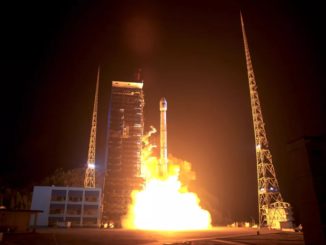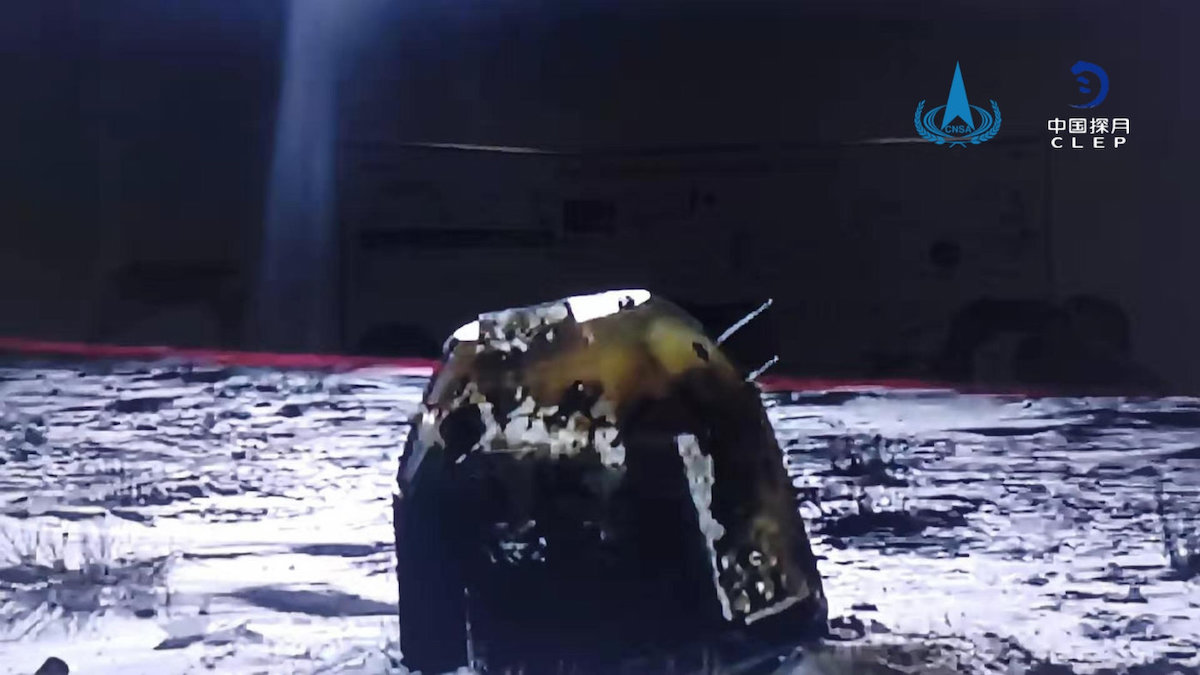
A capsule containing moon rocks landed in a remote, snow-covered corner of China Wednesday, bringing home the first samples from the lunar surface in 44 years and completing the Chinese space program’s most challenging robotic mission to date.
The return module appeared to have landed intact in China’s Inner Mongolia region, based on images broadcast on Chinese state television and released by the China National Space Administration.
Chinese officials confirmed the roughly 660-pound (300-kilogram) capsule landed at 12:59 p.m. EST (1759 GMT) Wednesday, or 1:59 a.m. Thursday in Beijing.
Recovery crews dispatched to the remote landing zone converged on the capsule in helicopters and off-road vehicles, traveling across the snow-covered plains of Inner Mongolia in the middle of the night. Ground teams reached the Chang’e 5 return module within minutes to begin operations to secure the capsule, and planted a Chinese flag in the frozen soil next the spacecraft.
Crews plan to transport the module to Beijing, where scientists will open the sample carrier and begin analyzing the moon rocks.
“Congratulations to China on today’s return of lunar samples to Earth!” tweeted Thomas Zurbuchen, head of NASA’s science mission directorate. “The international science community celebrates your successful Chang’e 5 mission. These samples will help reveal secrets of our Earth-moon system and gain new insights about the history of our solar system.”
The Chang’e 5 mission’s return to Earth capped a 23-day mission that successfully launched on China’s most powerful rocket Nov. 23, landed on the moon Dec. 1, collected samples, then took off again Dec. 3 to accomplish the first automated docking between two robotic spacecraft around another planetary body.
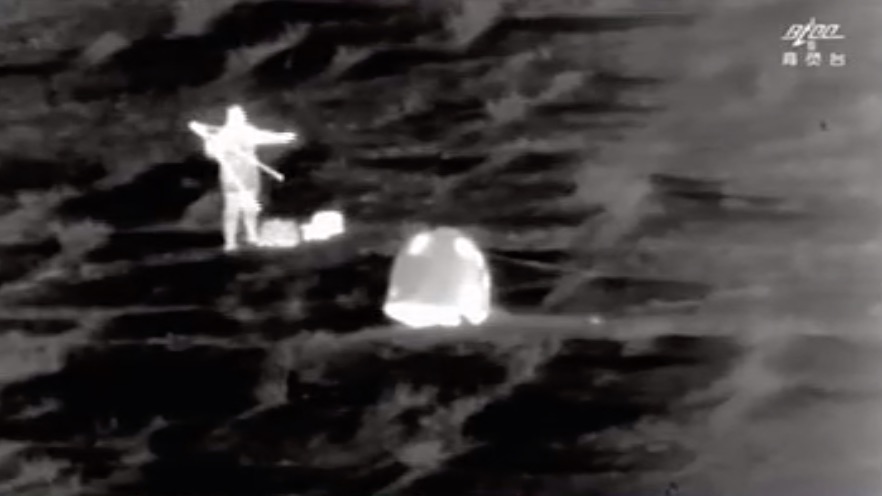
Chang’e 5’s ascender vehicle linked up with the mission’s return spacecraft Dec. 5, then transferred the capsule containing the moon rocks to the return craft before jettisoning and intentionally crashing into the moon Dec. 7.
With those steps completed, all that was left was to bring the lunar samples back to Earth.
Chang’e 5’s return spacecraft fired thrusters to raise its orbit around the moon on Friday, then performed a final departure maneuver Saturday (U.S. time) to head for Earth, according to the China National Space Administration. The 22-minute maneuver with four small thrusters provided the impulse necessary for the Chang’e 5 return craft to break free of the moon’s gravity.
The probe completed a course correction burn Monday and continued cruising toward Earth Tuesday, aiming for a landing in China’s Inner Mongolia region Wednesday.
Chinese officials did not disclose the exact landing time in advance, but public notices directing pilots to steer clear of the mission’s recovery zone were active during the expected time of the capsule’s re-entry. Chinese state media also did not broadcast the mission’s return to Earth live, but began video coverage after the capsule’s landing.
Chang’e 5’s return spacecraft released the re-entry capsule more than 3,000 miles (about 5,000 kilometers) over the South Atlantic Ocean, then performed an evasive maneuver, presumably to avoid entering the atmosphere and head back into space.
The capsule plunged into the atmosphere at 1733 GMT (12:33 p.m. EST), China’s space agency said.
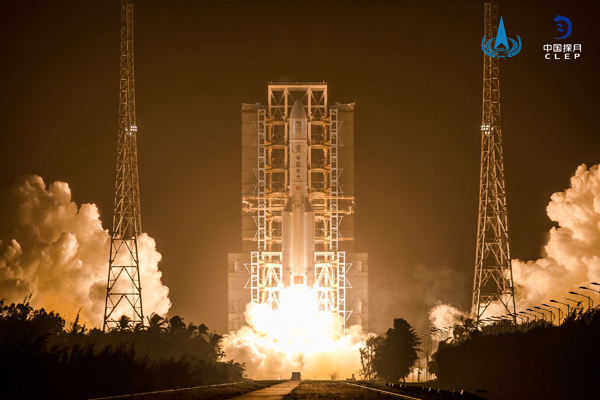
The re-entry capsule was designed to bounce off the atmosphere in a “skip re-entry” to slow the craft down before landing, diminishing its initial entry velocity from 25,000 mph, or 40,000 kilometers per hour, significantly faster than a re-entry from low Earth orbit. The skip re-entry also helped reduce heat the landing capsule will encounter during descent, Chinese officials said, before the craft deployed a parachute for landing.
Nine missions have returned moon samples to Earth, including NASA’s six Apollo missions with astronauts, and three robotic Luna spacecraft launched by the Soviet Union. NASA’s Apollo missions brought back 842 pounds (382 kilograms) of rocks from the moon.
The Soviet Union’s Luna 24 mission was the last mission to return rocks from the moon in 1976.
Chang’e 5 is the first Chinese sample return mission, following successful landings of Chinese spacecraft on the moon in 2013 and 2019. The landing in 2019, on the Chang’e 5 mission, was the first soft touchdown of a spacecraft on the far side of the moon.
Chang’e 5 landed on the near side of the moon in the Oceanus Procellarum, or Ocean of Storms, region, east of a volcanic plateau named Mons Rümker.
There is evidence that rocks in Chang’e 5’s landing zone are much younger than those returned by the Apollo astronauts. Those specimens are some 3.5 billion years old, created during a period of active volcanism in the first billion years of the moon’s existence.
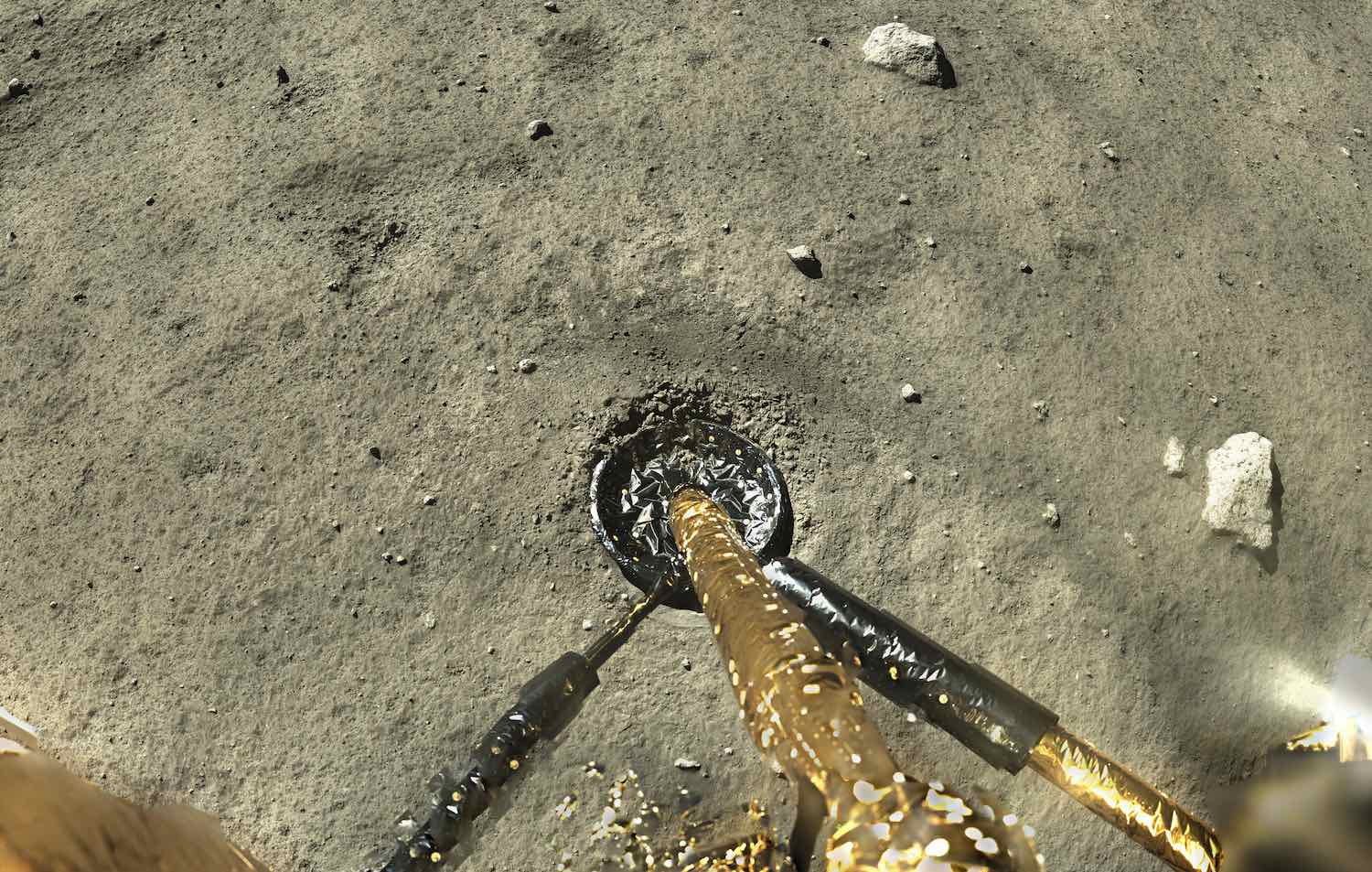
Lava plains to the east of Mons Rümker appear to be less battered by asteroid impacts, suggesting rocks there could be less than 2 billion years old. But models of the moon’s evolution suggest its internal heating should have diminished by that time, rendering volcanoes extinct, Neal said.
“It will be exciting to look at the age of these samples coming back and also the actual compositions of them,” said Clive Neal, a planetary scientist at the University of Notre Dame, in an interview with Spaceflight Now before Chang’e 5’s launch.
Chinese officials have said they plan to give international scientists access to the Chang’e 5 samples. The mission was designed to gather up to 4.4 pounds, or 2 kilograms, of lunar material using a subsurface drill and a scoop at the end of the lander’s robotic arm.
“Domestic and overseas scientists will all have a chance to get the lunar samples to be brought back by Chang’e 5 for research,” said Pei Zhaoyu, deputy director of the Lunar Exploration and Space Program Center of the China National Space Administration, in a report published by China’s state-run Xinhua news agency.
James Head, a planetary scientist at Brown University, told Spaceflight Now that international collaboration in the sample analysis will help foster greater scientific discoveries.
“Analysis of returned samples often requires very specialized and costly, sometimes unique, equipment and laboratories, that are not always evenly distributed worldwide,” Head said in a written response to questions from Spaceflight Now. “This means that national and international collaborations are really important in order to optimize the sample analyses. And of course, the amount of samples returned is not huge, and easily exhausted, so all of this needs to be factored into the distribution and optimization of returned samples.
“In Apollo, sample analysis were open to proposals from the international scientific community,” Head wrote.
“All of Apollo and Luna sites selected for sampling were old,” said Brett Denevi, a planetary geologist at the Johns Hopkins University’s Applied Physics Laboratory. “And of the sites that were on terrain shaped by volcanism, the volcanic eruptions occurred over 3 billion years ago.
“What is exciting about the Chang’e 5 sampling location is that it is on a volcanic deposit that may have formed closer to 1 billion years ago,” Denevi said. “That might sound old still, but for the moon, that would have been the last major gasp of volcanism, so those samples will give us what may have been the final chapter in the story of volcanic eruptions on the moon and how the interior of the moon evolved over time as eruptions waned.”
Denevi said once the Chang’e 5 samples are dated, scientists will have a “new anchor point” to estimate ages of planetary surfaces across the solar system.
“Older surfaces have more craters, younger surfaces have fewer, and because Apollo and Luna samples from those surfaces are mostly old, we know fairly well how the density of craters on a surface translates to its age,” she said. “So for places like the Moon, Mars, and Mercury we can estimate the ages of different regions based on how many impact craters have formed on them, even if we don’t have rocks from those regions.
“But for younger surfaces, we are doing a pretty rough estimate,” Denevi said. “We have no rocks of known age from a known surface between 1 and 3 billion years old. Chang’e 5 will change that, and allow us to better interpret the timing of events across the inner solar system.”
China’s next lunar mission, Chang’e 6, is similar to Chang’e 5 and will attempt to return rocks from the moon’s south pole region. It is scheduled to launch in 2023, according to Chinese space officials.
Future Chang’e missions will test out technologies for a future research station on the lunar surface, paving the way for Chinese astronauts to land on the moon, Chinese officials said.
Email the author.
Follow Stephen Clark on Twitter: @StephenClark1.


